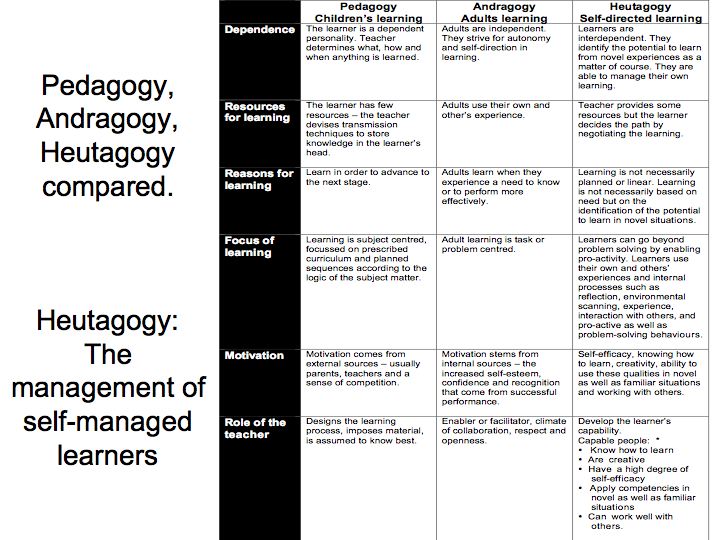And now there is heutagogy
Educators are pretty aware of the term pedagogy and frequently use and misuse it in conversations about their teaching. In K-12 education, all teachers have at least a general knowledge of educational theories and are required to attend professional development workshops on new techniques. But in higher education, many professors are willing to admit that they have little or no formal training on the art and science of teaching.
Pedagogy literally means "leading children." Most of the research in pedagogy by names like Piaget, Bruner and Vygotsky focus on teaching children.
Then, came andragogy, a much newer term coined to refer to the art/science of teaching adults. Originally used by Alexander Kapp in 1833, andragogy was developed into a theory of adult education by Eugen Rosenstock-Huessy and was popularized in the U.S. by American educator Malcolm Knowles. Andragogy addresses the theory that the methods used to teach children are often not the most effective ways of teaching adults.
And now, heutagogy, a term coined by Stewart Hase of Southern Cross University and Chris Kenyon in Australia. It is the study of self-determined learning. In some ways, it is an expansion and reinterpretation of andragogy. Heutagogy's emphasis is on learning how to learn, double-loop learning, and true learner self-direction. One way to view it might be to say that while pedagogy and andragogy look at how we teach, heutagogy is concerned more with the learner.
For example, Chris Argyris has described double-loop learning in which an individual, organization or entity, having attempted to achieve a goal on different occasions, is able to modify the goal in the light of experience or possibly even reject the goal. More common in educational settings is single-loop learning (SLL) which is the repeated attempt at the same problem with no variation of method and without ever questioning the goal.
The word heutagogy comes from several Greek words: heurista (to discover) and heuretikos (inventive) heuriskein (to find) and ago (to lead). Therefore, it is construed to mean "to lead to invention, discoveries, findings." Like andragogy, the research is based on learning strategies for mature learners.
The teacher/mentor/facilitator needs to enable learners to modify their learning in order to create new knowledge. I discovered the term only the past year as I explored MOOCs. Heutagogy fits well into the original approach to MOOCs which were very self-directed.
Heutagogy also seems to be related to the constructivism of Dewey, and approaches by Montessori and Kolb, although they were more concerned with children. In the taxonomy of Bloom, heutagogy is the highest order learning where problems are solved using heuristic problem solving, meta-cognitive knowledge, creativity, and originality.
Pedagogy literally means "leading children." Most of the research in pedagogy by names like Piaget, Bruner and Vygotsky focus on teaching children.
Then, came andragogy, a much newer term coined to refer to the art/science of teaching adults. Originally used by Alexander Kapp in 1833, andragogy was developed into a theory of adult education by Eugen Rosenstock-Huessy and was popularized in the U.S. by American educator Malcolm Knowles. Andragogy addresses the theory that the methods used to teach children are often not the most effective ways of teaching adults.
And now, heutagogy, a term coined by Stewart Hase of Southern Cross University and Chris Kenyon in Australia. It is the study of self-determined learning. In some ways, it is an expansion and reinterpretation of andragogy. Heutagogy's emphasis is on learning how to learn, double-loop learning, and true learner self-direction. One way to view it might be to say that while pedagogy and andragogy look at how we teach, heutagogy is concerned more with the learner.
For example, Chris Argyris has described double-loop learning in which an individual, organization or entity, having attempted to achieve a goal on different occasions, is able to modify the goal in the light of experience or possibly even reject the goal. More common in educational settings is single-loop learning (SLL) which is the repeated attempt at the same problem with no variation of method and without ever questioning the goal.
The word heutagogy comes from several Greek words: heurista (to discover) and heuretikos (inventive) heuriskein (to find) and ago (to lead). Therefore, it is construed to mean "to lead to invention, discoveries, findings." Like andragogy, the research is based on learning strategies for mature learners.
The teacher/mentor/facilitator needs to enable learners to modify their learning in order to create new knowledge. I discovered the term only the past year as I explored MOOCs. Heutagogy fits well into the original approach to MOOCs which were very self-directed.
Heutagogy also seems to be related to the constructivism of Dewey, and approaches by Montessori and Kolb, although they were more concerned with children. In the taxonomy of Bloom, heutagogy is the highest order learning where problems are solved using heuristic problem solving, meta-cognitive knowledge, creativity, and originality.

Image source & additional information at http://www.teachthought.com/learning/a-primer-in-heutagogy-and-self-directed-learning/
and at http://www.psy.gla.ac.uk/~steve/pr/Heutagogy.html (Stewart Hase and Chris Kenyon - 2001)
Comments
No comments